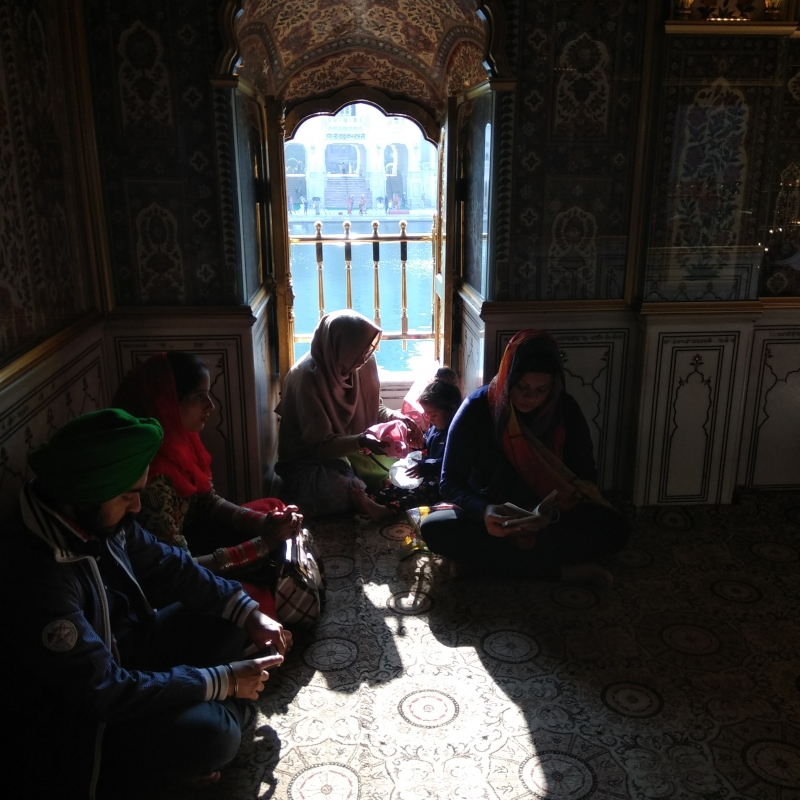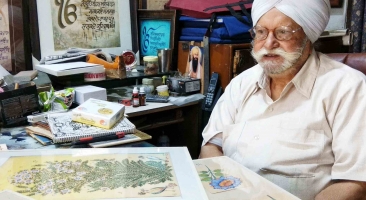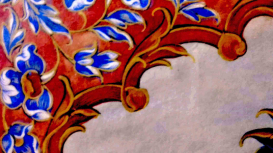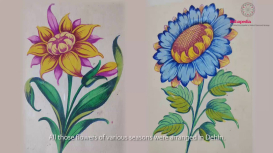Sachkhand, Sri Harmandir Sahib (also called Sri Darbar Sahib) was blown up thrice, between 1757 to 1764, by Ahmed Shah Abdali. In 1764, Maharaja Jassa Singh Ahluwalia (1718–83) and Misl Sikh chieftains took the initiative to rebuild Darbar Sahib that stands till date. In 1810, Maharaja Ranjit Singh on conquering Chiniot town (in 1764 Bhangi misl/ territories, now a province in the state of Punjab in Pakistan), was informed by one of his commanders about decorated wall paintings called mohrakashi (fresco) inside the havelis of the region. Maharaja Ranjit Singh (1780–1839), as an act of deep faith in Sri Guru Granth Sahib, took up the task of beautification through naqqashi at Darbar Sahib. Muslim artists from Chiniot town were invited to embellish the walls of Sri Harmandir Sahib. Maharaja Ranjit Singh entrusted the entire work of the decoration of the temple to Bhai Sant Singh and to Giani. Naqqash, was a term for a chitrakar, decorator or illuminator. They were also employed to undertake illumination of Arabic and Persian manuscripts, and sometimes they embellished specimens of calligraphy. Since the initial naqqashes for Darbar Sahib were from the Muslim and Vaishnav faiths, we find evidence of inspiration and influences from Vaishnav and Muslim creative vocabulary. Baba Kehar Singh was an eminent mohrakashi artist and evolved the renowned Sikh school of art. Floral decoration excelled under Rudh Singh, Amir Singh, Ganesh Singh, Gian Singh, Kapur Singh, Puran Singh, Aroor Singh and Bhai Gian Singh Naqqash. The latter is the last mural painter. After the demise of Maharaja Ranjit Singh in 1839, the task of completing the work was given to local artisans and naqqashes. Most of the naqqashes in Darbar Sahib remained unknown. We have been able to identify one undersigned as naqqash at Darbar Sahib i.e. Atma Singh Naqqash in 1960. Mohrakashi was never really recognised as an institutional art or was recognised for its unique visual language. From time to time artists, painters, conservators have engaged themselves in upholding the art form. The recent restoration of mohrakashi art has been done by Gurpreet Singh Mankoo assisted by many budding artists. This module introduces mohrakashi, explaining its process and delves into the legacy of Bhai Gian Singh Naqqash.
Mohrakashi and the Naqqashes of Harmandir Sahib

Dr Maneet Kaur
Dr Maneet Kaur is a researcher, academician, textile artist and designer. Under non-net fellowship, she completed her PhD on 'Evolution of Motif and Colour of Ikat in Gujarat, Orissa and Andhra Pradesh' from Design Department, Kala Bhavan, Visva-Bharati, Santiniketan. Prior to that she received fellowship on Small-study research grant on 'Bondo textiles' and 'Natural dyeing in Ikat Textiles from Lac and Jackfruit' from the Nehru Trust for the Indian Collection at Victoria and Albert Museum. Further she has submitted a documentary film on 'Bondo textiles of Orissa' to the handlloom office under Ministry of Textiles, Bhuwaneshwar, Orissa. She has taught as a Lecturer for a year in the Architecture and Interior School, LPU, Phagwara and as an Assistant Professor for two years in Design Department ApeeJay College of Fine Arts, Jalandhar. She has presented papers on 'Batik of Santiniketan', 'Kodpad Weavers', 'Telia Rumal of Pochampalli by Chiruveru Ramalingum', 'Crochet for Wearable', 'Punja Dhurries in Punjab' and 'Florals of Darbar Sahib' in seminars and conferences respectively. She has also been engaged in natural dyeing of silk, cotton and jute, designing organic jewellery, souvenirs with the folk artists and craft persons of Santiniketan; dhurries in natural dyeing with Nakodar weavers and introducing new motifs in Phulkari of Patiala.




